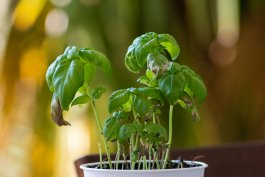
Sick basil plant
Basil, unfortunately, is susceptible to developing fungal and bacterial infections, such as gray mold, white powdery mildew, fusarium wilt, and black spot (affects leaves). Seedlings may also experience damping-off as well.
The two most common diseases—both caused by fungi—to afflict basil plants include fusarium wilt and root rot.
Fusarium Wilt
Fusarium wilt most commonly affects sweet basil varieties, but other basil plants are still vulnerable. Symptoms of fusarium wilt include:
- stunted growth
- wilted and yellowing leaves
- brown spots or streaks on the stem
- severely twisted stems
- leaf drop
Fusarium wilt is caused by a fungus, carried by either the soil of affected plants or by seeds from infected basil plants. There is no remedy for fusarium wilt. Destroy all infected plants as soon as you spot fusarium wilt—and don’t plant basil in that area for two to three years. Even if a basil plant cannot be affected by fusarium wilt, they can carry the disease and infect other plants. Planting disease-resistant basil is the only way to prevent fusarium wilt from attacking in the first place.
Root Rot
Root rot typically occurs when the soil is too soaked over an extended period of time. As the roots rot away, nutrient and water intake suffer, causing the leaves to yellow, wilt, and fall off the basil plant (usually the bottom leaves first). Basil plants need well-draining soil and only enough water to keep the soil damp 1 inch down. Fosetyl-al fungicide also helps prevent root-rot fungi from making an appearance. The best remedy? Ensure you don’t over-water your basil plants and that they have good drainage to begin with.
Avoid problems with diseases affecting your basil by waiting until the weather warms up before planting. Give your plants plenty of space between them for air circulation, since tight spacing can contribute to fungi and bacteria taking hold on your basil plants.
And here are two key basil-tending techniques that will serve you well:
Water your basil properly
Don’t under-water or over-water your basil plants. By keeping a regular watering schedule, you’ll keep your plants vibrant and healthy. Over-watering and watering directly on the plants—instead of the preferred watering method, directly at the stem on the soil—leads to consistently wet conditions, which allows bacteria and fungi to thrive and multiply.
Destroy infected plants
Throw away or burn infected basil plants. Don’t keep infected plants over the winter in your garden, and don’t throw them on your compost pile. Disease-ridden plants, even when dead, will spread the disease to other plants or even your soil.
Have you had problems with diseases attacking your basil plants? What types of problems do you regularly face with your basil? Please tell us how you treat and prevent diseases from destroying your basil crop.


 Previous
Previous


Tiny bugs got on my plants and the plants didn’t like being sprayed